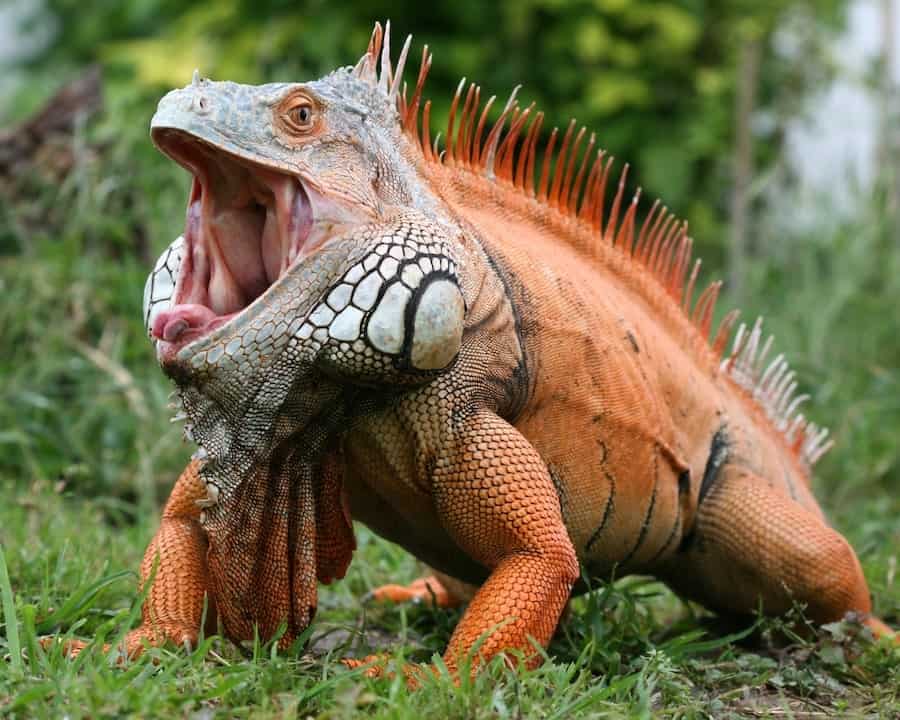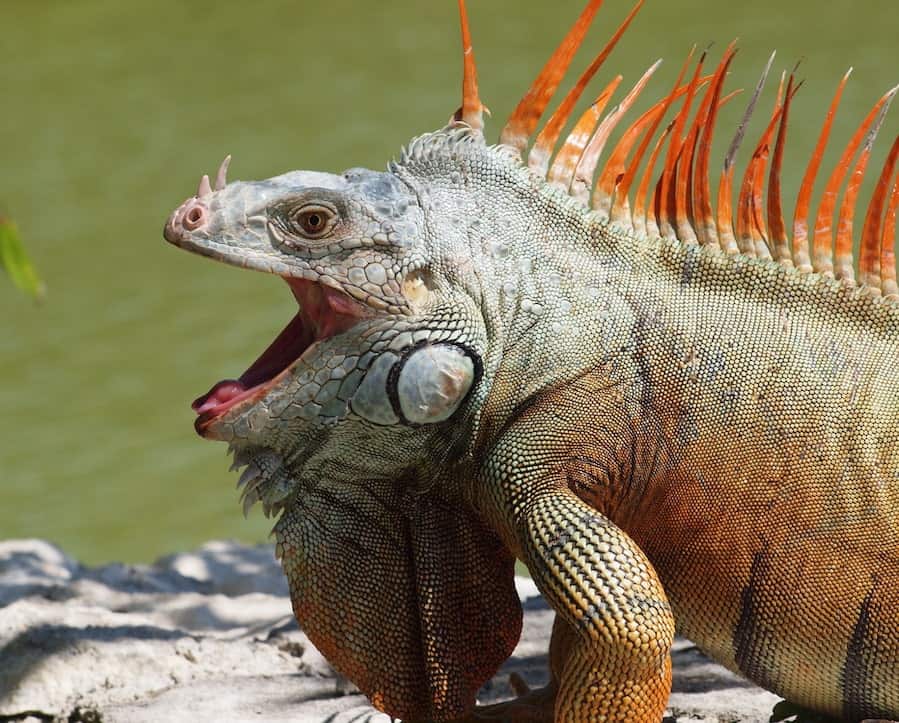Are you thinking about becoming an iguana pet owner? Or maybe you’re about to find yourself in a place where there are a lot of wild iguanas. Regardless, these beautiful creatures must be treated with respect, as they can pose a threat to your well-being.
As a general rule, iguanas can be dangerous. They have the potential to cause non-fatal injuries with their razor sharp teeth, claws, venom, and long tail, which they use to whip other animals and people if they feel threatened. They’re also known to contain harmful bacteria, especially if they’re feral.
Getting to know a little more about these large lizards is important if you wish to keep yourself and your loved ones safe.
Are Iguanas Be Dangerous?

Although iguanas are very unlikely to seek confrontation, such as by charging at you, they nevertheless, pose a danger to other animals and people via an attack and/or the harmful bacteria they can transmit.
It’s only when you get uncomfortably close to an iguana that it will feel the need to defend itself. At full maturity, a male green iguana can grow up to eight feet and weigh 20 pounds.
This is not a lizard you want to aggravate.
Fortunately, if you keep your distance, you have nothing to worry about.
However, you might be the new owner of an untamed lizard, and have no choice but to handle it. In such a case, you can expect a few lines of defense, which I’ll be happy to elaborate below.
Not sure what an angry iguana looks like? Check out this post I wrote titled, 7 Signs An Iguana is Mad: Ignore At Your Peril.
Iguanas Contain Venom
Unbeknownst to most people, green iguanas contain venom glands in their lower and upper jaws, which is injected when the iguana bites the victim.
Luckily, the venom is very weak, and although it can cause respiratory failure in extremely rare cases, it’s basically useless against humans.
Iguanas Can Bite

Iguanas can bite people if they feel the need to defend themselves, which usually occurs when the lizard is untamed or feral. Luckily, iguanas give many warnings before delivering the bite. The best thing one can do, is to give the iguana its space and avoid a mouthful of razor sharp teeth.
According to iguana expert, James Hatfield in his book, “Green Iguana The Ultimate Owner’s Manual,” an iguana’s mouth is full of razor sharp piranha-like teeth, which depending on its size, can total anywhere from 80-120, and can be replaced up to five times a year.
Therefore, a medium sized iguana can replace up to 500 teeth in just one year!
New teeth grow directly behind the old teeth, ensuring the iguana always has a set of sharp plant shears.
Due to enzymes in their saliva, humans begin to digest their food during the process of chewing.
However, iguanas have no such enzymes, and therefore, must thoroughly tear apart their food before swallowing. Hence, their teeth’s’ sharpness.
Unfortunately, their razor sharp teeth can spell disaster, as getting bit by a full grown iguana may require a trip to the emergency room followed by stitches.
Also, if the iguana has been infected by harmful bacteria such as Salmonella, the disease can spread through a bite, and may require additional treatment.
Check out this post I wrote about iguana bites and how to prevent them. It could save you a nasty injury and even a trip to the emergency room!
Iguanas Can Use Their Tails As Whips

As you’re probably already aware, an iguanas tail makes up the majority of the body, up to 60-67% of the total length to be exact.
The tail serves multiple functions including:
- Balancing the iguana while climbing
- Break to slow down a descent while climbing
- Propeller for swimming
- Whip-like weapon for defense
An iguana will detach it’s tail in a life-threatening situation to save its life, a process called caudal autonomy. However, the tail is not permanently lost, as it can be re-grown.
Since the tail is both long and replaceable, tail whips are more than likely the first form of defense against attackers.
Tail whips from a juvenile iguana can leave nasty welts that last days, while full grown iguanas can break a dog or cats’ legs with an accurate strike. Therefore, be very mindful of how close other pets get to your iguana.
For more info on how iguanas can be dangerous to dogs, check out this post I wrote called, “Can Iguanas Hurt Dogs? Keep Your Furry Friends Safe.”
A tail whip can break your skin, and like a bite, has the potential to transmit harmful bacteria. If you’re bitten, whipped, or clawed by a wild iguana, it’s always a good idea to get checked out by a doctor.
Iguanas Have Razor Sharp Claws

Iguanas have extremely sharp and powerful claws. The tip of the claws on my iguanas were so sharp that it was not at all uncommon for the nail to penetrate underneath my skin, and yes, it was very painful.
The iguanas’ claws, like its scales, are created from keratinized skin cells.
Many people falsely believe iguanas are arboreal animals (intended to live in trees), but they’re actually not, as the only reason they are good tree climbers are the sharp hooked claws.
Although an iguanas’ claws are not intended to be used as a form of defense, they can still induce damage to people by breaking the skin.
Believe it or not, an iguana can also transmit harmful bacteria via a scratch if it manages to break the skin.
Iguanas Can Contain Harmful Bacteria

If you’re an iguana owner, it should be important to note that, “ninety-five percent of iguana illness is due to poor husbandry” – Dr. Debra.
Therefore, it’s crucial that you get your iguana checked out by a vet at least once a year, and are familiar regarding proper care, as doing so can prevent the transmission of disease from lizard to human, and possibly a trip to the ER.
A wild iguana is much more likely to contain harmful diseases than a pet iguana, simply from the exposure to its environment as well as other iguanas.
Salmonella
You may have heard of people contracting Salmonella from uncooked meat or eggs, but it’s actually more common in reptiles and amphibians than people think.
According to the CDC, each year Salmonella infects 1.35 million people, is responsible for 26,500 hospitalizations, and 420 deaths, the majority consisting of food transmission. However, the numbers involving iguana infections have increased over the recent years.
Salmonella is the most common and dangerous type of zoonotic (disease that can be transmitted from animals to humans) that lives in iguanas’ intestines and can spread to any surface that came into contact with the infected iguana.
The disease is usually contracted from feces (you don’t even have to touch an infected animal), or by touching an infected iguana, especially if the contact consisted of an attack that broke the skin.
Signs of a Salmonella infection in people include:
- Diarrhea
- Abdominal cramps
- Fever
- Vomiting
Therefore, it’s imperative that you wash your hands immediately after handling any iguana, feral or domestic.
Should you experience any of the aforementioned symptoms, consult your licensed practitioner immediately, followed by a visit to the vet (once you’re all better of course).
Although Salmonella is not a big risk for healthy individuals, it can pose a big threat for high risk groups such as:
- Very young children
- Physically ill people
- Pregnant women
- The elderly
- People with a weak immune system
Therefore, the CDC highly recommends that homes with children under the age of five should avoid adopting a pet reptile.
If you wish to remove feral iguanas from your property while avoiding contact out of fear of contracting salmonella, I highly recommend getting in touch with professionals who know how to handle wild animals.
Are Male Iguanas More Dangerous Than Females?

Male iguanas can indeed pose more of a threat than females for various reasons.
Firstly, a mature male iguana is significantly larger than its female counterparts, sometimes reaching up to eight feet and 20 pounds! Females rarely exceed six feet and ten pounds.
Males will grow larger heads and jowls, making it easier for a male to cause more damage during a physical attack on humans.
Secondly, males are not only larger, but they’re also more aggressive, especially during mating season. Thus, increasing the chances of an attack.
With regard to disease, males and females both have the equal capacity to transmit illnesses.
Are Wild Iguanas More Dangerous Than Pet Iguanas?

Wild iguanas are definitely more dangerous than pet iguanas, as they’re less likely to be tamed, and therefore, more aggressive.
If you were attacked by a wild iguana, you should call your doctor right away, especially if the iguana managed to penetrate your skin in any way, shape, or form.
Since, feral iguanas come into contact with other iguanas, the likelihood of them containing harmful bacteria which can be transmitted to humans is more probable than pet iguanas.
How To Tell If An Iguana Is Dangerous

Unless you’re a veteran or have handled iguanas for many years, detecting a transmittable disease can be rather difficult.
However, knowing whether an iguana is about to attack is not.
Keep an eye out for the following signs to avoid a dangerous and aggressive iguana.
- An iguana will turn sideways and stiffen its tail to give off the appearance of being bigger, and therefore, someone you don’t want to mess with. This the usually your first warning.
- Sometimes, an iguana will bob its head up and down before turning sideways as a way of saying, “I’m not angry yet, but don’t come any closer. This is my territory, food, mate, etc.”
- An angry iguana will inflate its dewlap, the loose skin under it’s throat, to look bigger and more threatening.
- Hissing is a rare expression of anger, and only done by adults. The sounds is a result of the iguana filling its air with lungs and forcing it out through its mouth.
Need help taming your iguana? Check out this post I wrote titled, “How To Tame Your Iguana The Right Way.“

